Bioproducts are materials, chemical compounds and energy obtained from renewable biological sources. These incorporate agribusiness, forestry and organic waste among others. "Bioproducts" comprise a wide range of industrial and commercial goods that are described by a variety of properties, compositions and processes, just as many advantages and risks. Consequently, the expression "bioproducts" is a term that requires an assessment of the qualities of a specific item and the issues that arise on a case-by-case basis. There are several different types of bioproducts including:
Bioenergy is produced in liquid, solid or gaseous forms when organic matter is treated using different physical, biochemical, thermochemical and other types of processes.
Bioethanol is one of the most common bioproducts often blended with petroleum-based gasoline or diesel for transport or heating fuel. Typically, bioethanol is produced from the fermentation of various feedstocks that contain mainly fermentable sugars or carbohydrates. The available feedstocks for bioethanol can be categorised into four major types, as illustrated in Fig. 3.2.1. However, corn and wheat grains are still the two most popular sources for ethanol production, though new technology is now producing ethanol directly from cellulose or syngas (a mixture of carbon monoxide and hydrogen) but this costs more than grain produced ethanol.
Biodiesel has obtained increased interest as a nontoxic, biodegradable, and renewable diesel fuel. Being green energy, it could be a reasonable alternative for petroleum products. It can reduce air pollution by decreasing the levels of CO2, SO2, CO, and HC. The carbon cycle of biodiesel from biological resources is cost effective with respect to the photosynthetic process and burning emissions as a whole, especially because of the way that plants retain more CO2 than those released by the biodiesel consuming procedure. Accordingly, utilising biodiesel can adequately decrease the release of CO2, protect Earth ecosystems, and maintain the ecological balance, when compared with the utilisation of fossil fuels. The main concern with biodiesel fuel is its significant expense. It is normally created from vegetable oils, fats and oils in a procedure called transesterfication. Soybean and canola are examples of oilseed crops that can be utilised in biodiesel production just as reused vegetable oils from restaurants and fats from animal rendering (Fig. 3.2.2). The modern creation of oil-carrying microalgae for the production of biodiesel is also in progress. Biodiesel can be utilised in its pure form (B100) or mixed with petroleum diesel. Popular blends include B2 (2% biodiesel), B5, and B20.
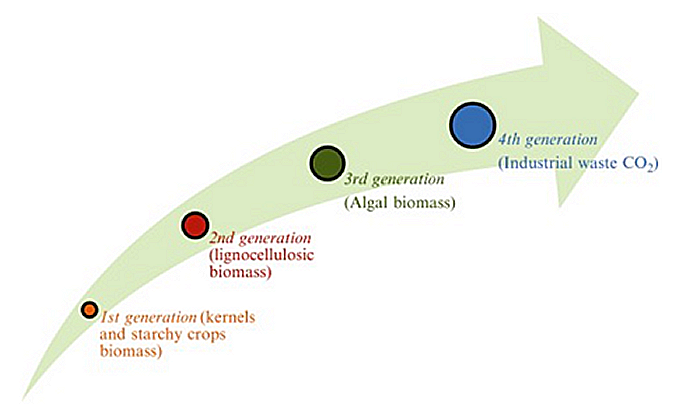
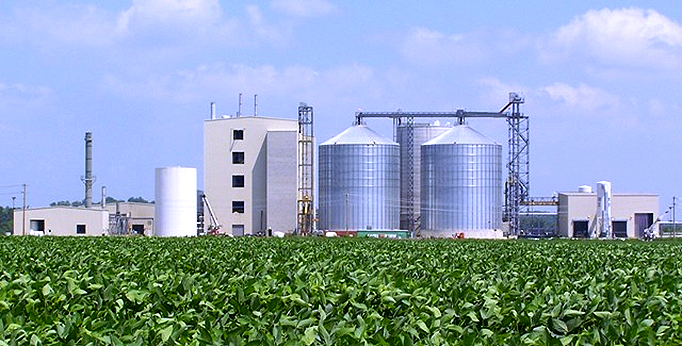
Biogas manufacturing is a well-known procedure for energy generation, nutrient recovery, and valorisation of natural deposits. It is produced from anaerobic digestion, a procedure wherein natural materials such as manure, rural harvest residues, dedicated energy crops and food processing residues are degraded by microorganisms, in anaerobic conditions to create methane for power and heat (Fig. 3.2.3). Generally, the biogas comprises methane, carbon dioxide, and other contaminating substances. The elimination or transformation of CO2 (biogas upgrading) and the purification from other impurities (biogas cleaning) are essential for improving the calorific value of biogas.
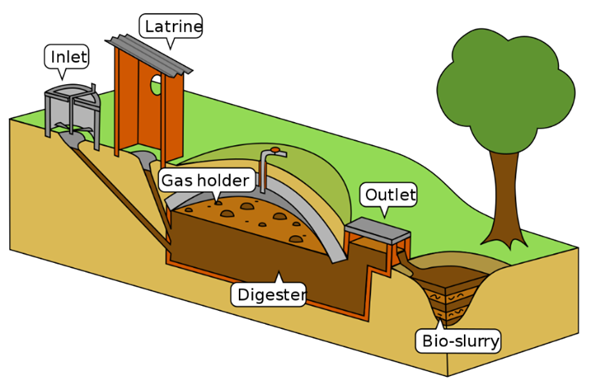
Biomass is a complex renewable material with substantial chemical fluctuation (Fig. 3.2.4). Its capacity for energy generation differs in regard to the method employed (from simple to highly sophisticated technologies). Since this natural resource can be found all over the world, its use for energy production and delivery of secondary products (solid, liquid, and gaseous fuels) should be reinforced thus improving the recovery capacities of agricultural, forestry, and industrial residues. Together with other renewable resources, such as solar, wind, and hydroelectric energy, biomass is a major future sustainable resource. Different crops such as switchgrass, agricultural crop residues (e.g. sunflowers), forestry and a wide range of organic matters can be burned directly or compressed into bioproducts such as briquettes and pellets for direct utilisation to produce heat and power. The most recent bioenergy technology comprises pyrolysis, gasification, solar-to-fuel and genetic manipulation of organisms to produce hydrocarbons.
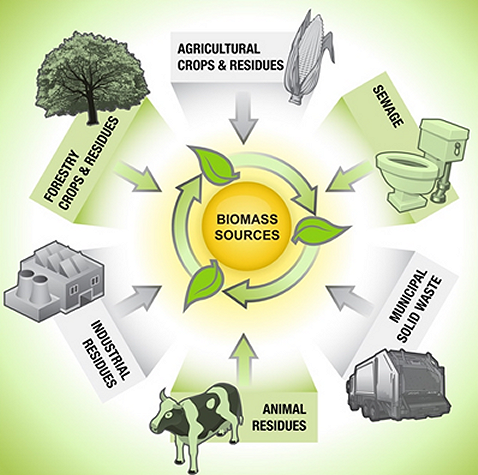
Late advances in natural fiber production, genetic engineering and composite research offer new prospects for development of improved materials derived from renewable resources. Thus enhanced support for global sustainability is achieved. Biofibres is one of them. They can be created and customised to meet different technical requirements. Biofibers are degradable, derived from natural sources as wood, agricultural crop residues and purpose-grown crops such as hemp and flax. Generally, they are used in furniture manufacturing, paper and textiles either all alone or mixed with petroleum-based polymers and resins to produce stronger, more solid biocomposite materials in the car, aviation and other manufacturing sectors.
The term "bioplastic" means a plastic material that is based (wholly or in part) on organic biomass rather than petroleum. Generally, they are produced from starch crops (e.g., corn, potatoes, wheat) and vegetable oils (e.g., canola or soybeans) (Fig. 3.2.5). Several types of bioplastics are known: starch-based, cellulose-based, protein-based, aliphatic polyesters, polyhydroxyalkanoates, bio-derived polyethylene, genetically modified feedstocks and lipid derived polymers. Bioplastics are biodegradable and are being adopted for a number of applications in automotive, electronics, food and beverage packaging, agriculture, textiles, health care, etc. Generally speaking, the greatest advantages of a growing bioplastic industry are a smaller energy footprint and less polluted ecosystems.
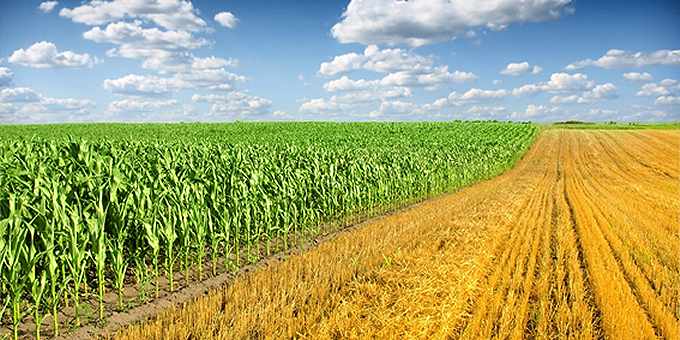
Biopharmaceuticals, such as sugars, proteins, nucleic acids, living cells, or tissues, are medicinal products derived by extraction or semi-synthesised from natural sources like humans, animals, or microorganisms. Unique in relation to traditional pharmaceuticals produced by chemical synthesis, most biopharmaceutical items are obtained from biological processes including the extraction from living systems or the production by recombinant DNA technologies.
Some biopharmaceuticals are plant-derived, including some vaccines, antibiotics and drugs, which have therapeutic value. For example, producing insulin from safflower could significantly diminish its cost.
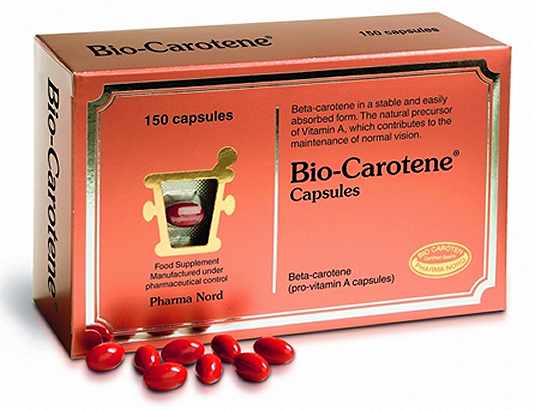
Biopharmaceuticals have multiple clinical applications and various advantages for disease therapy, prevention, and diagnosis.
Biopharmaceuticals are used in different therapies such as recombinant, protein, antibody, cell and gene therapy. They effectively and safely cure or treat diseases. By demonstrating biological activity they perform specific functions and influence the disease pathophysiology. In comparison with chemical drugs, biopharmaceuticals are more complicated, have various routes of administration and different pharmacokinetics.
Biopharmaceuticals can be used as vaccines for infectious disease prevention. They generally contain a biological agent that resembles a pathogenic antigen.
Apart from therapy and prevention, some biopharmaceuticals can be applied in diseases diagnostics. For example, monoclonal antibodies have been successfully applied in the diagnosis of some cancers and infectious diseases, and more are being developed.
Over the years the use of cosmetics has taken a new course. This is due, on the one hand, to the better access to information and has also been driven by the consumer's interest on the origin, safety, and sustainability of the products they purchase. Another class of personal care products referred to as biocosmetics have emerged through advanced technologies, such as nano- and biotechnology. These products are safe for humans, obtained in harmony with the environment, utilising numerous industrial wastes as raw materials, thus creating high-valued products and eliminating a significant amount of pollutants. Vegetable oils, starches and proteins are utilised as main raw materials for the production of a range of different types of cosmetics including deodorants, shampoos, make-up, sunscreens, beauty and personal hygiene products (Fig. 3.2.7). There is an expanding market interest for bioproducts, particularly to replace those currently made from petroleum-based sources.

Renewable chemicals are a new category of novel products. They are building blocks and ingredients for the production of chemicals, derived from renewable feedstock and sustainable advanced manufacturing processes, leaving a smaller environmental footprint than traditional petrochemicals and biobased chemicals. These products include biochemical intermediates and vegetable oils for sectors with higher value applications such as detergents, and biolubricants and chemicals for the oil industry. Example products include bioplastics, biologically based solvents, surfactants and lubricants where biodegradability and the avoidance of harmful emissions are primary considerations. Vegetable oils from corn, soybean and canola are typical organic matter used for the manufacturing of chemicals such as solvents, lubricants and adhesives. They can also be acetic acid, succinic acid, glycerol and methanol that can be used in the manufacture of high-value, bioproducts.
The chemical companies of all sizes and at every stage in the production chain are looking to produce and supply more of their chemicals from plant-based feedstock. Growing new crops or plants for isolation of bioproducts and renewable chemicals offers a wide range of potential benefits:
- decreased reliance on imported oil and polymers
- lowered greenhouse gas emissions
- sequestration of carbon dioxide
- availability of complex structures produced by natural synthesis
- novel valuable products
- new industries
- better consumer acceptance of biobased products
- improved utilisation of land resources, especially in marginal farming areas and rangeland irrigation development areas.
These advantages, of course, assume price competitiveness and a chemical and physical profile that is at least comparable with synthetic chemicals. Final price of biochemicals depends on the price of raw material, and the cost and availability of technology for processing. Multiple renewable chemicals are extracted from existing irrigated crops (relevant to the rangelands) (more 3.1.1).
Bio-based food and feed ingredients are the products used in food and feed industry which could be produced by any biotechnology process. These compounds could be from microbial, animal or plant sources, but also food wastes and side-streams from food and feed industries. The latter are potential sources to find different molecules and develop new ingredients as shown in Table 3.1.1. They are produced from biomass through fermentation or enzymatic hydrolysis.
| Food industry sector | Relevant bio-based products |
|---|---|
| Fruit and vegetable | Glucose, citric and linoleic acids, tocopherols, polyphenols, ascorbic acid, dietary fiber, pectins, and pigments. |
| Grain processing | Vitamins, minerals, key unsaturated fats, β-glucans, dietary fibre, antioxidants and different sterols. |
| Brewery and winery | Flavouring agents, enzymes, single cell protein (SCP), substrate for microalgae cultivation, cellulose and non- cellulosic polysaccharides, sugars, proteins, acids and antioxidants. |
| Marine | High caliber protein, lipids with high levels of unsaturated fatty acids, hydrolysates from fish guts/cleanings, peptides, and products from crustaceans such as chitosan, chitosan oligomers, glucosamines, omega-3 oils, chitin and chitosan, fish protein hydrolysates, algal constituents, carotenoids and antioxidants. |
| Meat | Bioactive peptides using hydrolysis or fermentation with antimicrobial, antioxidative, antithrombotic, antihyper- tensive or anticancerogenic activities. |
| Dairy | Solvent proteins (β-lactoglobulin, α-lactalbumin, immunoglobulin, bovine serum albumin, lactoferrin, and lactoperoxidase), high content of essential amino acids with antimicrobial, anticarcinogenic or biological activities. |
Bio-based food and feed ingredients constitute a growing market with big demand and competition. Bio-based food and feed ingredients have numerous applications in various sectors of the food industry such as dairy products, beverages, oils and fats, animal feed, infant nutrition, snack foods and bakery goods etc. and fall in six major categories:
- Probiotics: This term is used to name edible microorganisms with several associated health benefits for humans and animals. The probiotics market in Europe was valued at 100 million EU in 2010. The Western European market for probiotic bacteria cultures is focused on four areas - dairy products, animal feed, supplements and infant nutrition - and it was valued at EUR 30-36 million, and the US market was worth EUR 127 million;
- Prebiotics: Fructo-oligosaccharides that, when digested, have a positive impact on the composition of bacteria in the digestive tract. Nearly all carbohydrate-based food products, such as bread and cereals, but also margarines, fruit juices and dairy drinks, can be enriched with prebiotics. The fructan market (which includes inulin and fructo-oligosaccharide) is the biggest segment. The fructan market reached EUR 180 million in 2010, attracting several new market participants;
- Dietary fibers: Dietary fibers are increasingly used to replace fat in food dietary products;
- Peptides: Bioactive peptides and proteins are a group of functional ingredients of growing interest due to their functional properties, e.g. anti-cholesterol, anti- inflammatory and antioxidant properties. Their major applications are in sport drinks and animal feed;
- Terpenes: The terpenes sub-category of carotenoids includes beta-carotene, lycopene, astaxanthin and lutein - which are also widely used for animal feed, as food coloring, in cosmetics, in pharmaceuticals and in dietary supplements. The beta-carotene on the market is usually synthetic and its production is concentrated at DSM and BASF, which have a combined share of over 80%. However, the use of naturally- derived carotenoids is increasing, particularly in functional food and health food applications;
- Phenols: Polyphenols, being traditional food colorants, are increasingly marketed as antioxidant food ingredients. Latest researches focused on the study of polyphenols suggest that these molecules can protect against cancer and cardiovascular diseases, as well as increase anti-inflammatory activity.
- Nutraceuticals: The term "nutraceutical" is a blend of two words: "nutrient" (a nourishing food compound) and "pharmaceutical" (a medicinal product). The term was invented in 1989 by Stephen DeFelice, founder and chairman of the American organisation named Foundation for Innovation in Medicine. Nutraceuticals is a broad term that is used to describe any product obtained from food sources with more health benefits in addition to the basic nutritional value found in foods. They can be considered non-specific biological therapies used to stimulate general well-being, control symptoms and prevent malignant processes.
Bio-based animal feed co-products are also generated through biorefinery processing for the production of biofuels, mainly bioethanol and biodiesel (more 3.2.2). Currently, co-products are an important feed resource in many countries, for ruminants, non- ruminants and aquaculture. Due to the expansion of the feedstock used for bio-fuels production (from first to second generation), several co-products have been introduced in the global market and can be used as livestock feed. This trend is on-going, increasing both in complexity and in the number of livestock species that are benefiting.






